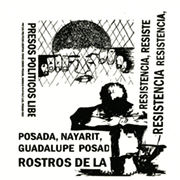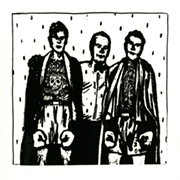Reinterpretations of Posada: Posada como resistencia
by Cristian Ramirez
The art of José Guadalupe Posada is a source of inspiration for contemporary Mexican artists. In 2006, the politically engaged artist collective La Curtiduría from San Felipe del Agua, Oaxaca produced a signed, limited-edition portfolio of 38 silkscreened prints significantly entitled Calavera oaxaqueña: homenaje a José Guadalupe Posada.
This portfolio was an homage to José Guadalupe Posada. Several artists made graphic artworks related to the social, gender, and class issues that concern Oaxaqueños. Thirty-eight graphic artworks were printed by different artists, with a few of them found inside La Curtiduría’s first issue of their publication La Patria Ilustrada. Titling the publication La Patria Ilustrada is also a deep tribute to Posada because Posada's first employer was a journal of the same name. While the images are untitled, the name of each artist is next to the image they have created. Each image is clearly inspired by Posada given that they incorporate a variety of styles which Posada used in his work. Like Posada, the images of the artists that participated in this project speak for themselves and are worth a thousand words (Tyler 63-64). An end to femicide and social inequality, a quality education system, and justice for those killed from the War on Drugs are what these images ask for. The artistic style Posada used during his time is recycled to direct people's attention to societal struggles in Oaxaca.
Dionisio Martínez
This artwork is one of many that represent and call for resistance in Oaxaca. Artists recreate past art styles to generate awareness of corruption's longue durée since the era of Posada's artwork, and here we see Posada's name in the work. The artist, Dionísio Martínez, demands that political prisoners be released and reminds us that the faces of resistance continue to resist. On the left side within the smallest font, a portion reads "Todos Somos Posada." The political resistance associated with Posada catches people's attention as Oaxaqueños are connecting the past with the present. In La Patria Ilustrada, a section lists the governors that have betrayed the people of Oaxaca. The author, Juan Carlos Cruz Rojas, is creating a bridge linking corruption from the past to the present. Similarly, Martínez makes the connection here that corruption has existed from the time Posada's art was being distributed to the present day. The battle between corruption and the artwork designed to address it manifests itself again in a contemporary form hoping to build a better future.
Demián Flores
In this image, La Curtiduría founder Demián Flores incorporates a theme of boxers drawn from some of his past works. Some of his previous works with boxers or luchadores are from 1999 with imagery of Arena México, a professional wrestling arena. Another amazing work by Flores includes Naturaleza from 2005 which shows two men with pre-Columbian Nahua iconography on their clothes, with one wearing a luchador mask and blocking the other man from punching him. In this work we notice that the boxers have imagery associated with the nation of Mexico. As to who exactly the boxers are is difficult to know, however, we see that the one on the left has Posada's famous calavera garbancera on his shirt, while the other has La Virgen de Guadalupe. Reusing the calavera is the obvious identifier to the homage of Posada in this image, but La Virgen might also be a tribute to Posada's middle name, "Guadalupe.” From the figures stances it is unclear whether they are about to fight or if the fight just ended, but whatever the case may be, both boxers represent two major icons in Mexican national identity. La calavera garbancera is an indigenous woman who tries to be European and denies her indigenous roots. Similarly constructed by indigenous people, La Virgen de Guadalupe has been connected with the Nahua indigenous representation of Coatlicue. How is this related to the Oaxacan resistance to the state? Both women are rooted in indigeneity and mixed with European influences, just like mestizaje. This image may also be a preparation for battle or to show that La Virgen and Posada's spirits live within Oaxaqueños when they fight for what is right.
Adriana Audiffred
Adriana Audiffred's piece as an homage to Posada includes two calaveras with crowns, possibly a king and a queen, and to their right sit two columns of skulls. Here, Audiffred incorporates many references to famous images and styles of Posada: calaveras, royalty, chess, and medieval themes. We know that Posada incorporated many calaveras as part of his artwork, as well as portrayals of royalty. The two columns of skulls also resemble a chess board, as in Posada's El Jicote N.9, he aquí la realidad, fig. II. Posada also referenced a European medieval style in his art which can be seen in La Ninã de los ojos de luz or El lego sabio. We do not who the calaveras with crowns are specifically, but the crowns point to royalty or perhaps elites more broadly. Given La Patria Ilustrada's theme of resistance, the calaveras with crowns could be the Oaxacan elites that have ignored the people. The columns of skulls may represent how sacrifices on a tzompantli (skull rack) were practiced during pre-Columbian times, or an association with the people of Oaxaca sacrificing themselves for a better standard of living.
Works Cited
Flores, Demián. Naturaleza. 2005. http://www.demianflores.com/works.php?criteria=t*prints&y=2005.
Flores, Demián. Arena México. 1999. http://www.demianflores.com/works.php?criteria=t*prints&y=1999.
Guadalupe Posada, José. El Jicote N.9, he aquí la realidad, fig. II. 1871, Museo Nacional de Arte, Mexico City, http://66.111.6.112/objects/3711/el-jicote-n-9-he-aqui-la-realidad-fig-ii;jsessionid=E552F25B1AA5F797FD79C88ABDB131C9?ctx=ead2c941-5210-4a0e-99b0-885c16c16aeb&idx=63.
“Jean Charlot Collection: José Guadalupe Posada Prints.” University of Hawai’I at Mānoa Library, 28 Dec. 2021, https://guides.library.manoa.hawaii.edu/c.php?g=769711.
La Curtiduría. “Calavera Oaxaqueña.” La Curtiduría Centro de Artes Visuales, https://lacurtiduria.com/2008/05/21/calavera-oaxaquena/.
Tyler, Ronnie C., et al. Posada's Mexico. Washington, Library of Congress, 1979.



